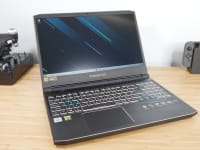Pros
-
Impressive gaming performance
-
Smooth, high-refresh display
-
Great connectivity
Cons
-
Dim and dull display
-
Disappointing keyboard
-
Not good for content creators
About the Acer Predator Helios 300
- Processor: Intel Core i7-10750H
- Graphics: Nvidia GeForce RTX 3070
- RAM: 16GB
- Storage: 512GB
- Display: 1080p, 240Hz IPS display
- Wireless connectivity: Wi-Fi 6, Bluetooth 5
- Wired connectivity: 3x USB-A, 1x USB-C, 1x HDMI 2.0, 1x Mini-DisplayPort 1x Ethernet, 1x 3.5mm audio
- Webcam: 720p
- Battery: 4-cell Lithium-Ion
- Weight: 5.51 pounds
- Size: 14.3 inches wide, 10 inches deep, .9 inches thick
- Warranty: One-year limited warranty
One key specific leaps out from this laptop’s spec sheet: the Nvidia GeForce RTX 3070 graphics card. Available for $1,699 as tested, the Acer Predator Helios 300 is among the most affordable RTX 3070 laptops on the market. Most competitors are at least a couple hundred dollars more. Razer’s Blade 15 is $1,999 when similarly equipped.
It’s good this stands out, because the laptop’s hardware is otherwise unimpressive. This is a thick, wide, heavy machine that keeps to the safety of tried-and-true components. All of this contributes to the Helios 300’s low price, but the pursuit of value ultimately leaves this laptop winded and trailing its competition.
What we like
Game performance is good for the price
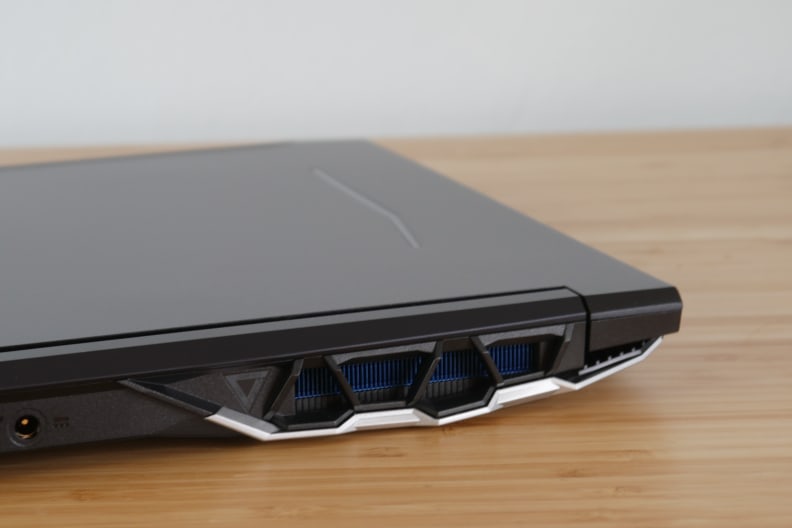
Serious performance means serious air vents.
A gaming laptop isn’t much use if it doesn’t perform, but Acer’s Predator Helios 300 has plenty of go. It’s powered by an Intel Core i7-10750H processor and Nvidia RTX 3070 mobile graphics. Intel’s six-core processor isn’t that impressive, especially considering what AMD’s Ryzen 5000-series brings in comparison, but the Nvidia GPU easily makes up for its shortcomings.
We saw strong scores across our entire range of benchmarks. 3DMark’s Fire Strike test, which measures gaming graphics performance, spat out a score of 20407, one of the highest we've recorded to-date. But more important than synthetic benchmark scores is the actual in-game performance; Metro Exodus exceeded 72 frames per second (fps) at Ultra detail and 1080p resolution, while Shadow of the Tomb Raider averaged 102 fps at Highest settings and the same resolution. 60 frames a second is the minimum to hit these days, but obviously the RTX 3070 blows right past that.
These figures beat most gaming laptops we’ve tested in the past year. This includes an Acer Predator Triton 500 we reviewed with Nvidia RTX 2080 SUPER, an Asus TUF A15 with Nvidia RTX 2060, and a Razer Blade Advancedwith Nvidia RTX 2080 Super MAX-Q.
One laptop the Helios 300 doesn’t beat is the new Asus ROG Strix G15 AMD Advantage Edition. This laptop’s AMD Radeon RX6800M graphics led it to victory over the Acer across our test suite, sometimes by a wide margin (it averaged 25 fps quicker in Metro Exodus, for example).
It’s not a blowout, though. AMD hardware can’t beat Nvidia in ray tracing (the technical term for rendering realistic lighting effects in real-time), which is supported by an increasingly large number of games. While AMD announced an AI-driven upscaling feature to improve performance in these situations, it won’t be available until June 22, and it’s still not clear what specific games will support it from that date moving forward.. Metro Exodus, for example, will not support AMD FidelityFX Super Resolution due to compatibility issues with its rendering techniques. Nvidia’s similar feature, called DLSS, is supported by dozens of games, including Metro Exodus.
Gamers have a decision to make: Do you want an Nvidia-powered laptop and all the brand-specific perks that go with it, or an AMD-powered laptop that’s faster in games that don’t lean on cutting-edge features? It all depends on the games you play.
If you decide Nvidia is for you, the Helios 300 is your go-to value laptop from a sheer graphics performance standpoint. It’s among the least expensive RTX 3070 laptops sold right now, undercutting most competitors by at least a couple hundred dollars.
The 240Hz display is wonderfully smooth
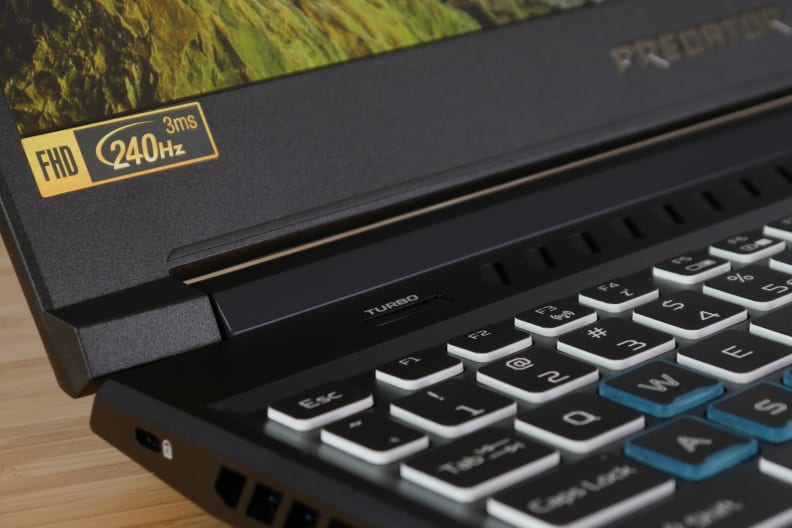
The Acer Predator Helios 300 has a dedicated Turbo mode button so you can quickly switch between performance profiles.
Acer kicks the refresh rate up to 240Hz for the Predator Helios 300. This is not unusual for a modern gaming laptop, but it's an upgrade over the already impressive 144Hz refresh rate that’s becoming the standard even on budget machines these days.
A 240Hz refresh rate means the display can refresh its image up to 240 times each second. That’s four times better than the 60Hz refresh rate of a typical office monitor. Objects in motion look more defined and are less likely to show motion artifacts, like a blur or trail. Competitive titles that rely on quick reactions, like Counter-Strike or Rocket League, will feel extremely responsive. You’ll be able to pick out details that would otherwise be obscured.
High refresh rates are only useful if your gaming PC can output a framerate high enough to take advantage of them. A 240Hz refresh rate requires an input of 240 frames per second for best results. This is more than the Helios 300 can achieve in most titles even with detail settings turned down. However, it’s possible to exceed 200 fps in less demanding games, such as Rocket League. It helps that the display has a maximum resolution of 1080p, which demands less of the RTX 3070 than would a 1440p or 4K screen.
There’s no shortage of connectivity
Gaming laptops are often thick and heavy, but this leaves space for lots of connectivity. Acer’s Predator Helios 300 takes full advantage of all that space.
This laptop has four USB ports, three USB-A and one USB-C, along with Ethernet, HDMI, an audio jack and Mini-DisplayPort. We’d prefer to see a full-sized DisplayPort instead, as this would eliminate the need for an adapter when connecting to a monitor. Most laptops don’t include DisplayPort at all, though, so this is a nitpick.
It’s hard to find more wired connectivity from a modern laptop. All ports are located along the left and right flanks of the laptop, aside from the proprietary power connector, which is on the laptop’s rear.
Wi-Fi 6 is supported through Intel’s Killer Wi-Fi AX1650i. This delivers superior performance over the more common Intel Wi-Fi 6 AX201 wireless solution. The Acer Predator Helios 300 reached peak Wi-Fi speeds of up to 200 Mbps in a detached office located 50 feet (and several walls) away from a TP-Link AX50 router. Laptops with Intel’s AX201 can struggle to break 100 Mbps in this type of location. You’ll appreciate this when your favorite game needs a 20GB patch.
What we don’t like
The display’s speed comes at the cost of quality
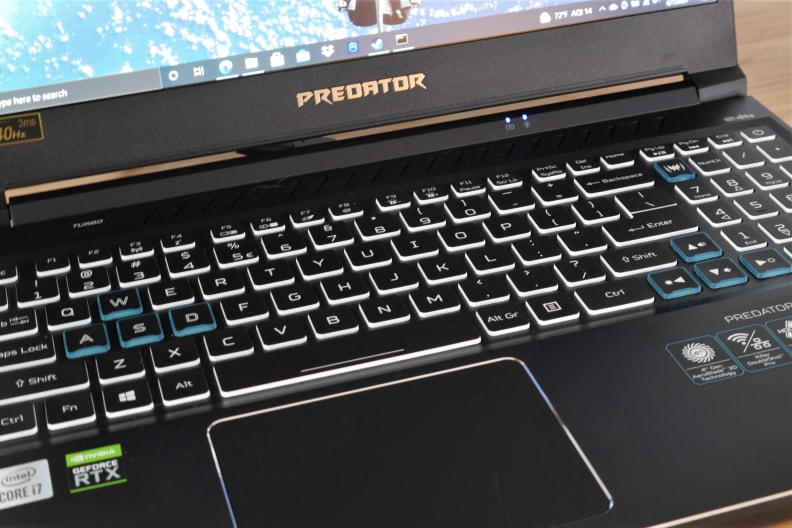
Unfortunately, we found the keyboard too cramped and mushy for a gaming laptop.
The smooth, 240Hz display is great for competitive games, but it comes at the expense of quality in visually demanding games like Metro Exodus that can’t achieve high framerates. The 1080p display often leaves games looking dull and washed-out.
Brightness, not resolution, is the issue—the 1080p 15.6-inch screen packs about 140 pixels into every inch, which is more than most desktop monitors. However, I measured its maximum brightness at 280 nits and maximum contrast ratio at just 1000:1. These figures are mediocre for a modern gaming laptop.
Color performance isn’t great, either. Color accuracy is fine, but the laptop’s color gamut is a bit narrow. In other words, it fails to deliver the full spectrum of color you’ll find on other laptops. That translates to a tepid, flat appearance that dampens colorful games like Final Fantasy XIV.
Acer needs to work on its keyboard
The most charitable thing I can say about the Helios 300’s keyboard is that it exists and can be used to type words without too many errors. It’s otherwise a disappointment. The keys feel sloppy and squishy, providing minimal tactile feedback.. On occasion, I felt as if I didn’t fully activate a key, though it would in fact be registered.
Despite the laptop’s size, Acer’s decision to include a numpad means the keyboard doesn’t feel spacious. The numpad pushes the typing position to the left, so you’ll find yourself leaning and scrunching in that direction.
The Helios 300’s keyboard would’ve worked five years ago, but times have changed. Many modern gaming laptops, such as Razer’s Blade, Alienware’s m15, and even some MSI and Lenovo models, offer keyboards that are genuinely great to use, sometimes with mechanical switches even. Acer falls short of that mark.
Creators will be disappointed
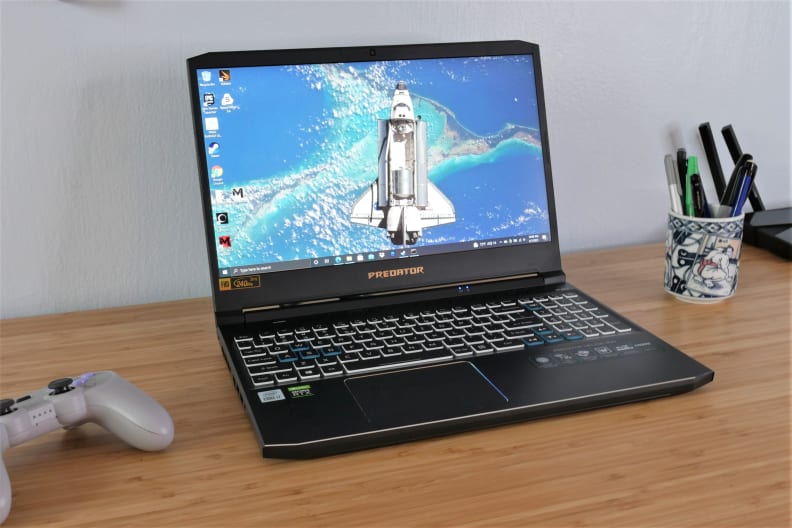
The 240Hz display is great for esports gaming.
Gaming laptops can double as workstations for content creators, providing a high level of performance at prices that, next to ThinkPad or Latitude workstation, look like a bargain. Razer and Alienware know this market well. Acer? Not so much.
Aside from its connectivity, which is great, the Acer Predator Helios 300 fails to reach a broad audience. I’ve already hammered it for a lackluster display and keyboard, but there’s more to it than that. Every element of the laptop, from the bad webcam to the so-so touchpad and chunky design, sink the laptop’s hopes of appealing to anyone but the most hardcore gamers.
Acer might counter that it has a line of laptops for creators: ConceptD. The comparison is apt because Acer’s ConceptD 7 Pro looks very similar to the Predator Helios 300, but packs a 4K display instead of a 1080p high-refresh display.
The problem, though, is that some of Acer’s competition doesn’t force creators to choose. A Razer Blade or Alienware R15 can deliver excellent performance in games but also pack a display, keyboard, and battery life more suitable to creators’ needs.
The bloatware is annoying
The Acer Predator Helios 300 seems bent on bringing bloatware back. (It's also seems to be a relatively common thing on lower-priced machines.) Our review unit came loaded with junk including Norton antivirus, pop-up advertisements, and lots of pre-installed apps like ExpressVPN, Dropbox, Spotify, and an Acer-branded take on CyberLink’s video editing software, PowerDirector.
None of this detracts from the laptop’s performance. Those programs don't take up much space on the hard drive, and the amount of memory they use is negligible. Still, it takes away from the overall experience. Part of a new PC’s appeal is a fresh start free of countless apps installed over years of use, but the Helios 300 feels stale from the moment you turn it on. Worse, none of the included third-party apps are likely to appeal to gamers.
Battery life is not great
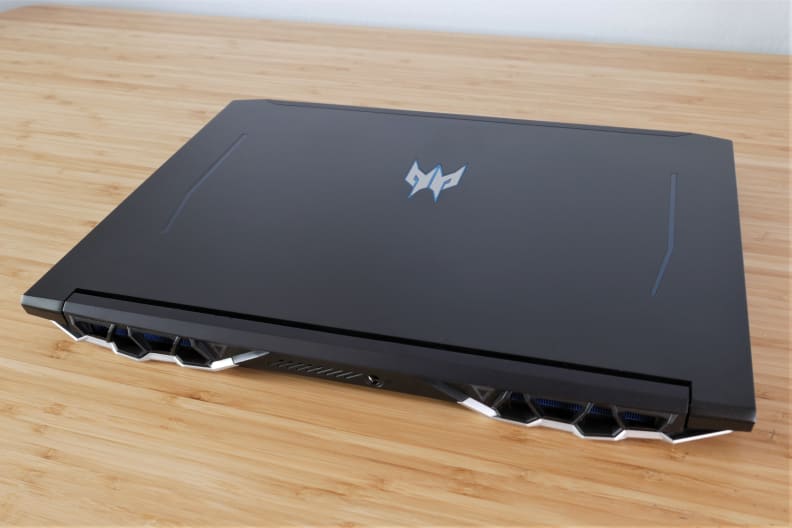
The Acer Predator Helios 300 weight over five pounds, but it needs to be a little hefty to handle all that performance under the hood.
Plan to use your laptop away from an AC outlet? Acer’s Predator Helios 300 is not for you. We measured just two hours and thirty minutes of battery life in our standard battery benchmark, which uses automation to simulate web browsing. This is below average even for a gaming laptop.
I put the battery to a real-world test by hauling it to a local coffee shop. The Helios 300 performed just as expected, ripping and tearing through the battery in a shocking display of voltage violence. After two hours of work, I left with the battery clinging to less than twenty percent of a charge.
This is where alternatives from Razer and Alienware have an edge. They’re not more efficient but pack larger batteries that provide more endurance. The last Razer Blade Advanced we tested lasted three hours in our standard battery test. Asus’ Strix G15 AMD Edition, meanwhile, lasted an impressive nine hours on battery. The Helios 300’s battery is more of an emergency backup than something to rely on in normal use.
Should you buy it?
No, Acer needs to go back to the drawing board
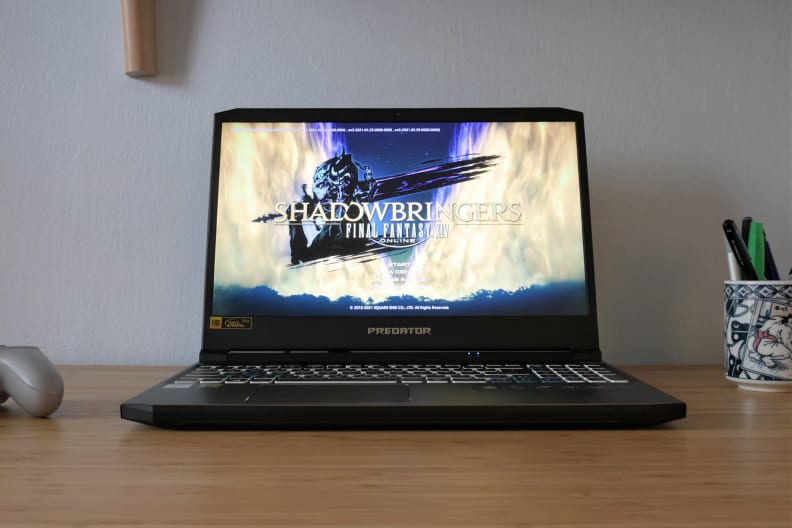
The Acer Predator Helios 300 looks nice, but some aspects of its design weren't impressive.
Acer’s Predator Helios 300 comes in a variety of configurations at multiple price points. I favorably reviewed last year’s entry, but the model I tested had a price tag of just $1,199. This new RTX 3070-powered Helios 300 is priced at $1,699, which pits it against serious competition.
Alienware’s m15 R4 is currently available with similar hardware for about $1,750 on Dell’s official website, while Razer’s Blade 15 is $1,999, again with similar hardware. These laptops are well worth a small increase in price. Then there’s the deep breath Asus ROG Strix G15 AMD Advantage Edition which, despite its long-winded name, can beat the Helios 300’s performance when ray tracing isn’t a concern.
The Helios 300 could be attractive as a sort of external graphics card for a desktop gaming setup. Attaching the laptop to an external monitor, keyboard, and mouse bypasses most of its flaws. There’s something to be said for performance in today’s world of sky-high GPU prices.
This is a niche use, however. Most people buy a gaming laptop that will be used at least partially as a laptop, and that’s where the Helios 300 falls flat. Its keyboard, display, battery life, and design are sorely in need of an update, especially if Acer plans to keep selling Helios 300 configurations above $1,500.
Meet the tester
Matthew S. Smith is a veteran tech journalist and general-purpose PC hardware nerd. Formerly the Lead Editor of Reviews at Digital Trends, he has over a decade of experience covering PC hardware. Matt often flies the virtual skies in Microsoft Flight Simulator and is on a quest to grow the perfect heirloom tomato.
Checking our work.
Our team is here to help you buy the best stuff and love what you own. Our writers, editors, and experts obsess over the products we cover to make sure you're confident and satisfied. Have a different opinion about something we recommend? Email us and we'll compare notes.
Shoot us an email


